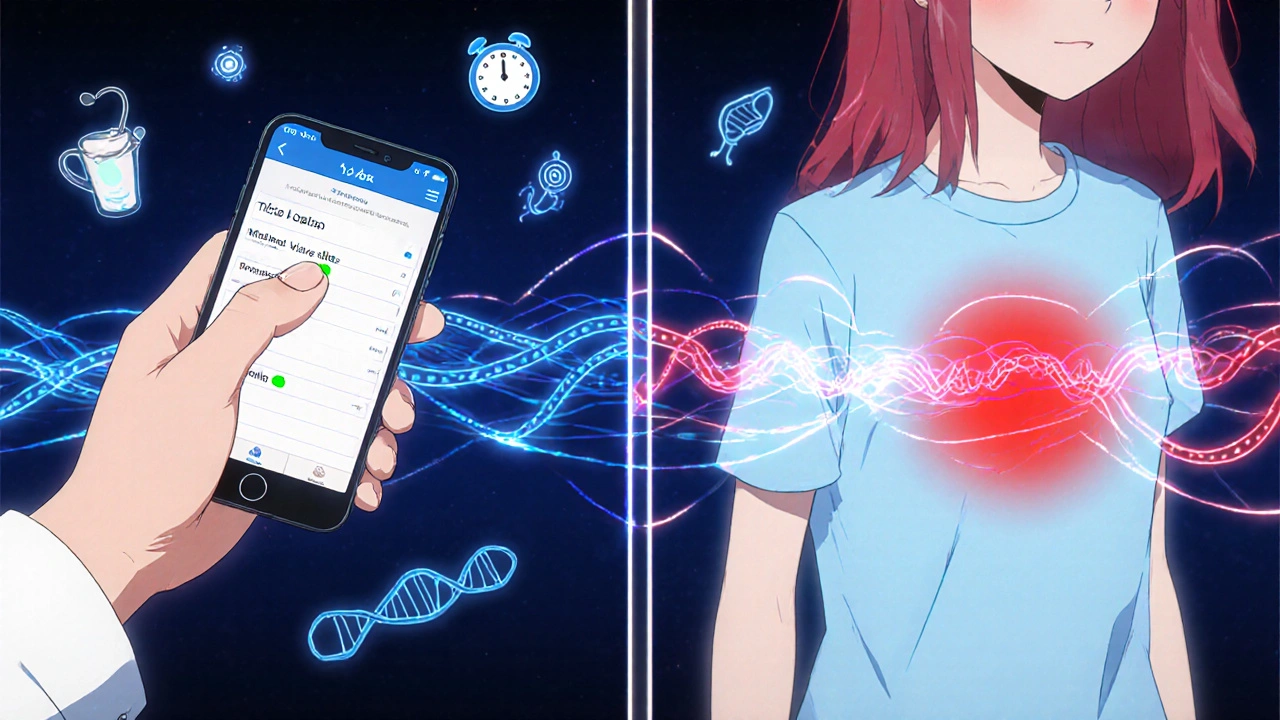
When you start a new medication, it’s normal to wonder: is this feeling caused by the drug, or is it something else? Dizziness after taking blood pressure pills? Nausea after antibiotics? A rash that showed up two days after starting a new supplement? These aren’t just inconveniences-they could be signs of a drug reaction. And if you don’t track them, your doctor might miss the connection entirely.
Keeping a symptom diary isn’t about being overly cautious. It’s about giving your healthcare team the clearest possible picture of what’s really happening in your body. Studies show that patients who document symptoms as they happen are 83% more likely to help doctors identify a true drug reaction than those who rely on memory alone. In one case, a patient’s dizziness was dismissed until they showed a 14-day log linking it directly to their levodopa doses. The doctor adjusted the dosage within 48 hours. That’s the power of a well-kept diary.
What to Record in Your Symptom Diary
A good symptom diary doesn’t just say “I felt weird.” It answers the questions your doctor will ask before they even ask them. The National Institute on Aging (NIA) and FDA guidelines outline nine essential data points you need to capture for every reaction:
- Exact time and date you took the medication-down to the minute. If you took it at 8:15 a.m., write that. Not “around 8 a.m.”
- Dosage and route-how much you took and how (pill, injection, cream, etc.). If you took 50 mg of metoprolol, write it. If you switched from a pill to a patch, note that change.
- Other medications and supplements you took that day. This includes OTC painkillers, vitamins, herbal teas, or even CBD oil. Many reactions happen because of interactions, not the drug alone.
- What you felt-and where. Don’t say “I felt bad.” Say “I felt a sharp tingling on my left forearm, starting at 10:20 a.m., lasting 45 minutes.”
- When the symptom started after taking the drug. Did it hit 20 minutes later? 4 hours? 12 hours? Timing tells you whether it’s likely linked.
- How long it lasted. Did it fade after an hour? Did it come and go all day?
- What you were doing at the time. Were you walking? Sleeping? Stressed at work? Hot outside? Environmental factors can trigger or worsen reactions.
- What you did to feel better. Did you lie down? Take an antihistamine? Drink water? Record it all.
- How severe it was. Use the CTCAE scale: Grade 1 (mild, no interference), Grade 2 (moderate, limits activity), Grade 3 (severe, medical intervention needed), Grade 4 (life-threatening), Grade 5 (death). You don’t need to be a doctor-just be honest. “I couldn’t get out of bed” = Grade 3.
One patient documented a rash after starting a new cholesterol drug. She wrote: “Red, itchy patch on upper chest, appeared 3 hours after taking 40 mg atorvastatin. Temperature: 78°F, no sun exposure. Took diphenhydramine. Improved by next morning.” That single entry gave her allergist everything they needed to confirm a reaction-no extra tests required.
Use a Tool That Works for You
Some people swear by paper notebooks. Others find apps easier. Both work-but only if you actually use them.
Handwritten diaries are fine if you’re consistent. But studies show that 57% of people abandon paper logs within three days because they’re too slow or messy. If you forget to write it down right away, you’ll forget the details. And if you write “headache” on page 3 and “dizzy” on page 7, you won’t see the pattern.
Apps like Medisafe, CareClinic, and MyTherapy solve this by sending reminders, auto-timestamping entries, and turning your data into charts. You can tap a button to log a symptom, pick from a list of common reactions, and even attach a photo of a rash. These apps meet FDA standards for electronic records and sync with your phone’s health data-so if your heart rate spiked at the same time your nausea started, the app flags it.
But here’s the catch: apps only help if you use them daily. Set a daily reminder at the same time you take your meds. If you miss a day, don’t try to backfill. Just start fresh tomorrow. Perfection isn’t the goal-consistency is.
Don’t Document Everything-Just the Unusual
Not every side effect needs to be logged. Feeling slightly drowsy after taking allergy medicine? That’s expected. But if you suddenly feel like you’re floating, your lips swell, or your vision blurs-that’s not normal. That’s what you need to record.
Doctors see hundreds of patients. If your diary is full of “mild headache” and “tired,” they’ll tune out. But if you show three episodes of rapid heartbeat after taking a new beta-blocker, they’ll pay attention. A 2022 study found that 41% of diaries had so much irrelevant data that doctors missed serious reactions because they were buried in noise.
Ask yourself: Is this something I’ve never felt before? Is it worse than I expected? Does it interfere with my day? If yes, log it. If no, skip it. Focus on what’s new, unusual, or concerning.

Timing Matters More Than You Think
Memory fades fast. After 48 hours, your brain starts filling in gaps with guesses. That’s why the NIH says you must document serious symptoms within 72 hours-and ideally, within 15 minutes of onset.
Think of it like this: if you get a rash after taking a new antibiotic, you’ll remember the rash. But you might forget that you ate sushi that same day. Was it the drug? The seafood? The diary locks in the exact timeline so your doctor can rule out other causes.
Set alarms on your phone: one for when you take your meds, and another 30 minutes later to log symptoms. If you’re away from your phone, scribble notes on a sticky note and transfer them later. Don’t wait.
Share It With Your Doctor-Regularly
A diary is useless if it sits in your drawer. Bring it to every appointment. Don’t wait for a crisis. Even if you feel fine, show your doctor your last two weeks of entries.
Many patients report that doctors respond differently when they see concrete data. One woman said her psychiatrist kept telling her her anxiety was “just stress” until she showed a diary proving her panic attacks started every time she took her antidepressant. The doctor switched her medication the same day.
Ask your doctor: “Based on what I’ve recorded, should I stop, reduce, or switch this drug?” Don’t just hand them the diary-ask for their interpretation. That’s how you turn data into action.
What to Do If You Spot a Serious Reaction
Some drug reactions are emergencies. If you experience any of these, seek help immediately:
- Swelling of the face, lips, tongue, or throat
- Difficulty breathing or wheezing
- Severe dizziness or fainting
- Rapid heartbeat or chest pain
- High fever with rash or blistering skin
Don’t wait to check your diary. Call 911 or go to the ER. Then, after the emergency, go back to your diary. The details you record afterward will help prevent this from happening again-either to you or someone else.

Common Mistakes and How to Avoid Them
Even well-intentioned people mess up. Here are the top three errors-and how to fix them:
- Forgetting other medications-71% of errors happen here. Write down every pill, patch, or drop you use, even if you think it’s unrelated.
- Not noting the environment-89% of diaries miss this. Was it hot? Were you stressed? Did you sleep poorly? These can trigger or worsen reactions.
- Inconsistent timing-63% of incomplete diaries have wrong or vague times. Use your phone’s clock. Don’t guess.
Pro tip: Print a simple checklist and tape it to your medicine cabinet. Check off each item as you log it. It takes 30 seconds-but it saves hours of confusion later.
Why This Matters Beyond You
Keeping a symptom diary isn’t just personal. It’s public health. When thousands of patients log reactions, drug manufacturers and regulators see patterns. That’s how dangerous drugs get pulled from the market. That’s how safer dosing guidelines are created.
The FDA now accepts direct patient reports in their adverse event database. Your diary could help someone else avoid a reaction you experienced. That’s powerful.
And it’s not just about drugs. It’s about control. Too many people feel powerless when they’re on medication-like they have to just “deal with it.” But when you track your body’s responses, you’re not just a patient. You’re an active partner in your care.
How long should I keep a symptom diary?
Keep it for as long as you’re taking the medication-and for at least 2 weeks after you stop. Some reactions, like skin rashes or nerve issues, can appear days or even weeks after stopping a drug. If you start a new medication, begin the diary the day you start it. Don’t wait for symptoms to appear.
Can I use a regular notebook or do I need an app?
You can use either. Paper works if you’re consistent and write details right away. But apps are better for most people because they send reminders, auto-log time, and help you spot patterns. If you’re not tech-savvy, start with a printed template you can fill out by hand. The goal isn’t the tool-it’s the habit.
What if I forget to log a symptom?
Don’t try to guess or backfill. Just note the date and write “missed entry.” Forgetting happens. The key is to keep going. Your diary doesn’t need to be perfect-it needs to be honest and ongoing. One missed day won’t ruin it. Two weeks of inconsistent logging will.
Should I log expected side effects like dry mouth or fatigue?
Only if they’re new, worse than usual, or interfere with your daily life. Dry mouth from an antihistamine? That’s normal. But if your mouth is so dry you can’t swallow or speak, that’s not. Fatigue from a new blood pressure pill? Maybe. But if you’re sleeping 12 hours a day and still exhausted, that’s a red flag. Use your judgment: if it’s surprising or disruptive, log it.
Can a symptom diary help me get off a medication I don’t need?
Yes. Many people stay on medications longer than needed because doctors assume symptoms are from other causes. A diary showing that your headaches started after beginning a new drug-and disappeared after stopping it-can be enough evidence for your doctor to discontinue it. One patient documented that her bloating and brain fog vanished 3 days after quitting a supplement she’d been taking for 2 years. Her doctor called it a “textbook case” and thanked her for the clarity.
Do I need to show my diary to every doctor I see?
Yes-if they’re prescribing, adjusting, or reviewing your medications. Even your pharmacist can help spot interactions. Bring your diary to every appointment where drugs are discussed. If you’re seeing a specialist, send them a summary ahead of time. Most doctors appreciate it. Some even ask for it.
Next Steps
Start today. Pick one medication you’re taking and begin logging. Don’t wait for symptoms. Start now, so you have a baseline. Use a notebook, a phone app, or a printable template. Set a reminder. Write down the time you take your pill. Then, 30 minutes later, ask yourself: “Did I feel anything different?”
If you’re unsure what to write, use this simple formula: What? When? Where? How bad? What did I do? That’s all you need.
And if you’ve been ignoring symptoms because you thought they were “just part of aging” or “no big deal”-stop. Your body is talking. Your diary is the microphone. Use it.




I started using MyTherapy after my last meds switch, and honestly? Game changer. I used to forget everything, then I’d show up to appointments with ‘I felt weird sometimes.’ Now I can show my doc exact times, dosages, and even linked it to my sleep tracker. One day I noticed my heart raced every time I took my beta-blocker at night-turned out it was the caffeine combo. Doc changed my schedule, no more midnight panic attacks.
Don’t overthink it. Just log the weird stuff. You don’t need perfection-just presence.
Epistemologically, the symptom diary functions as a hermeneutic apparatus-a phenomenological scaffold that externalizes the somatic hermeneutic of pharmacological subjectivity. The act of inscription transforms the body from a passive vessel into an active semiotic field, where physiological anomalies become textual signifiers amenable to clinical deconstruction.
Yet, the ontological paradox persists: if the symptom is logged post-hoc, does it retain its phenomenological integrity, or is it merely a reified artifact of performative self-surveillance? The FDA’s algorithmic bias toward quantifiable metrics risks reducing corporeal experience to data points devoid of lived temporality.
Just wanted to add-when you log ‘what you did to feel better,’ include *how well it worked*. Not just ‘took diphenhydramine,’ but ‘took 25mg, waited 45 min, itching reduced by 70%.’ That’s gold for doctors. I had a rash that kept coming back, and my allergist had no clue until I showed the pattern: every time I took the antihistamine, it helped but didn’t fully resolve. Turns out I was allergic to the dye in the pill, not the drug. Tiny detail, huge impact.
As a healthcare communicator with over 15 years in patient education, I must emphasize: this post is exemplary. The structure aligns with CDC and WHO best practices for patient-reported outcomes. The emphasis on specificity, temporal precision, and environmental context is not merely helpful-it is clinically essential.
For non-native English speakers or those with cognitive load challenges, I recommend using voice-to-text apps with pre-loaded symptom templates. Many hospitals now offer free, HIPAA-compliant versions. Consistency, not complexity, is the goal. Thank you for elevating patient agency.
bro this is lit 🙌 i been logging my meds since i started on that new antidepressant and i caught a weird reaction i didn't even know was weird-my hands got cold as ice every time i took it at night. thought it was just anxiety. turns out it's vasoconstriction. doc switched me and now i'm chill.
you don't need to be perfect. just be real. your body knows. you just gotta listen and write it down 📝🔥
I love this. I’ve been keeping a diary for my thyroid med for 18 months now. I used to think I was being ‘too much’-until my endocrinologist said, ‘You’re the only patient who brings me a timeline.’
One entry: ‘Tired at 3 p.m., pulse 98, ate sushi at noon, took med at 7:30 a.m.’ → Turns out, iodine + levo = temporary hyperthyroid spike. No more sushi on med days.
Don’t feel silly for writing it down. You’re not overreacting-you’re outsmarting the system.
It's profoundly significant to recognize that the act of maintaining a symptom diary transcends mere documentation-it constitutes an act of epistemic resistance against the paternalistic structures of conventional medical paradigms. When patients systematically record their physiological experiences with precision and fidelity, they reclaim agency in an ecosystem that often reduces them to passive recipients of clinical authority.
Furthermore, the integration of digital tools that synchronize with biometric data streams (e.g., heart rate variability, sleep architecture, galvanic skin response) represents not merely a convenience, but a revolutionary convergence of phenomenological subjectivity and objective physiological validation. The data collected does not merely inform treatment-it transforms the doctor-patient relationship into a collaborative, evidence-based co-inquiry. This is not just self-care; it is participatory medicine in its most authentic form.
man why you all overthinking this? just write down what you feel when you feel it. i had this crazy headache after my new blood pressure med, thought it was stress. turned out it was the med + my pre-workout. doc said ‘why didn’t you tell me you took that?’ i said ‘i didn’t think it mattered.’ now i log EVERYTHING. even the dumb stuff.
your body ain’t lying. you just gotta stop ignoring it.
This is why America’s healthcare is broken. You’re telling people to log every little twitch and tingle like they’re scientists? Meanwhile, people in other countries just take their meds and live. We’ve turned medicine into a spreadsheet obsession.
Next thing you know, we’ll be requiring patients to submit a 500-word essay before each refill. This isn’t empowerment-it’s bureaucratic gaslighting disguised as ‘patient engagement.’
Used this method for my statin. Started logging after I got that weird muscle ache. Wrote: ‘Pain in right thigh, 2 hrs after 20mg atorvastatin, no exercise, temp 72°F, took ibuprofen, 40% relief.’ Showed it to my doc. He said, ‘We’ve been seeing this pattern for months. You’re the first to track it this well.’
Switched me to a different statin. No more pain.
Don’t wait for a crisis. Just start. 30 seconds a day. That’s all it takes.